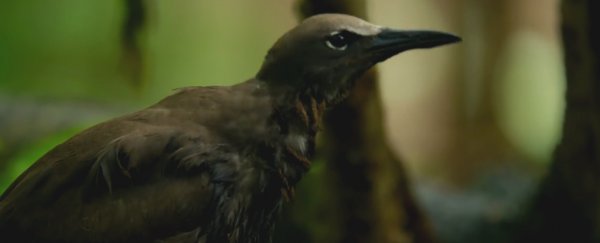It's not unusual for plants to stick, prick, or entangle their seeds into some hapless animal that steps too close in search of a meal or a place to rest.
But one genus of tree found in the tropical waters of the Indian and Pacific oceans has taken this method of distributing its seeds a little too far, killing many of the birds that land in its branches by weighing them down and preventing them from flying away.
The thing is, there doesn't seem to be a clear reason for this wanton slaughter, leading one ecologist to suggest that it's just one of those macabre quirks of evolution.
Alan Burger from the University of Victoria in Canada had heard of the Pisonia tree and its killer reputation back in the 1990s, so travelled to Cousin Island in the Seychelles to take a closer look at a population of Pisonia grandis and its seabird colonies.
Many of the tree's species produce long seeds coated with a thick mucus and small hooks, which stick to almost anything that brushes against them, including insects and many of the seabirds – such as noddies – that land or nest in the tree.
What sets the Pisonia apart from other trees that use glue or prickles to hitch a ride is that these seeds can pile up rather quickly – especially if a bird falls or lands among the pods on the ground – weighing down smaller individuals and making it impossible for them to fly.
If they're not picked off by a passing scavenger or predator, most birds die and decompose at the foot of the tree. Some poor victims can sometimes be seen still stuck high in the branches, as Jason Bittel at The Washington Post so colourfully puts it, "like macabre Christmas tree ornaments".
This isn't some occasional mishap either; it's so common, the Pisonia has been nicknamed 'the bird-catcher tree'.
Burger wondered if there might be some evolutionary motive for this crime, or if the tree was just misunderstood.
For over 10 months in 1999 and 2000, he conducted experiments to determine what benefits – if any – the plant received by having dead birds covered in its seeds.
The most obvious place to start was with the nutrient-rich corpses rotting into the soil under the tree's branches seeds.
Oddly enough, Burger found that the seeds that sprouted near the bird carcasses didn't seem to survive better or grow faster than those that grew further away, so it doesn't appear that the carcasses benefit the Pisonia all that much.
In addition, the tree received far more fertiliser from the bird's droppings, indicating they were worth far more to the tree alive than dead.
Burger then tried immersing Pisonia seeds in seawater on the hunch that the dead birds might act as efficient rafts in dispersing seeds to other islands.
Unfortunately, the seeds died after just five days in the water, ruling out any great advantage in using the birds' remains as some kind of ark.
On the other hand, Burger found by dunking the seeds occasionally in seawater over a period of four weeks, they still germinated.
From this he concluded the seeds probably evolved to hitch a ride on the live seabirds, but sometimes just happened to kill a few along the way.
"Having the birds alive seems to be the key to dispersal, but an unfortunate consequence of having extremely sticky seeds, and producing many seeds in a cluster, is that some birds get fatally entangled," Burger told The Washington Post.
Burger's work on the Pisonia was published in the Journal of Tropical Ecology way back in 2005, so why is it coming up now?
David Attenborough's new BBC documentary series Planet Earth II has a fantastic segment on the bird-catcher tree, which you can glimpse a preview of below:
It's tempting to think every behaviour or trait we see in nature was evolved to suit some specific purpose.
And, of course, it's possible that one day it might provide some advantage to the tree, or the noddies that rest in it might evolve characteristics that make it less susceptible to the seeds' sticky grasp.
One species of turtle dove feeds on the Pisonia's seeds, and while they still stick to their feathers, they seem to avoid any fatal entanglements.
For now, it seems, the tree's potentially deadly seeds are simply a reminder that sometimes nature DNGAF.
